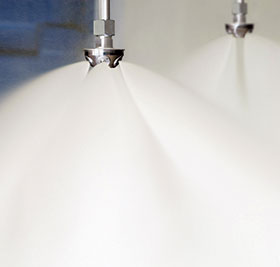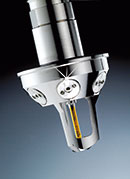

Sperosens, a Danfoss-Semco partner, recently embarked on developing and introducing high-pressure water mist into the southern African market. During experimental tests and demos, the effectiveness of water mist was clearly seen.
During a test of the cooling effect of water mist, a petrol and diesel pan fire (1 m by 1 m) was started inside a 6 m container. A pre-burn period was used for the fire and heat to fully develop. A sprinkler system with four sprinklers operating at a total flow rate of 1 000 litres per minute was compared to one water mist nozzle operating at 40 bar and 9 litres per minute. The sprinkler system did not manage to suppress or extinguish the fire, while the mist nozzle was able to effectively extinguish the fire within 8 seconds. Using a thermal camera to visualise the heat release and reduction rates, it was seen that after activation of the mist system, the ambient temperature inside the container drastically reduced from in excess of 150°C to under 45°C after the mist was activated, proving and demonstrating the unique properties and life safety benefits that water mist has to offer.
History of water mist
Water mist fire suppression technology was introduced in the 1940s and was mainly used for specific applications, such as protection of passenger shipping vessels like ferries. The major focus of the technology was focused on the life safety the fire suppression system offered. The technology grew due to the efficiency in controlling and extinguishing mechanisms as well as suppressing hydrocarbon mist explosions that water mist offers.

Due to the development and increased interest of Halons (namely Halon 1301 and 1221) in the 1960s to 1970s, water mist was phased out. Halons, at the time, proved to be the most efficient fire suppression chemical to ever be developed. As regulations became stricter due to the concern of the adverse negative environmental effects of Halon, they were phased out and a renewed interest in water mist developed.
Over the past two decades, interest in water mist as a fire suppression systems technology increased significantly. As technology grew, the capability and understanding of water mist grew. By 1996, there were over 50 agencies around the world that were involved in research and development of water mist, ranging from theoretical investigations of the extinguishing mechanisms to testing and development of mist generating equipment and hardware. The major focus of this development was to show that water mist has the potential to replace current fire protection techniques that are not environmentally acceptable and to find solutions to inefficiencies that current traditional technologies cannot answer.
Water mist defined
Water mist, according to NFPA 750, the Standard on Water Mist Fire Protection Systems, defines water mist as a fine mist/fog spray were the Dv99 (99% of the distributive summation) of all the droplets is less than 1000 µm in diameter. The standard also defines that low-pressure systems operate at less than 12.1 bar, intermediate-systems between 12.1 bar and 34.5 bar, with high-pressure systems operating at 34.5 bar and above. The focus is to break the water into extremely fine water particles and distribute a tested and proven amount of water mist flux into the risk area.
Water mist has extremely favourable properties that make it a preferred fire suppression system compared to other technologies. When considering the fire triangle, current fire technologies attack only one side of the triangle, mainly heat in the case of water based systems, and oxygen in the case of gas-based systems. Water mist has the advantage that due to the small particle size and distribution means, it behaves like a gas suppression agent and has the cooling properties of a water suppression system. Water mist is divided into primary and secondary extinguishing mechanisms.
Primary mechanisms
Heat extraction:
• Cooling of the fire plume.
• Wetting and cooling of the fuel surface.
Displacement:
• Displacement of oxygen at the flame front.
• Dilution of fuel vapour.
Secondary mechanisms
• Radiation attenuation.
• Kinetic effects.
When comparing water mist particle size to traditional sprinkler and spray systems, the heat extraction effect that mist presents is magnitudes larger than conventional systems. As the water particle decreases, the surface area exposed for heat transfer increases. Water mist is therefore able to absorb/remove more heat per volume of water than conventional systems. Water has a sensible heat capacity of 4.2 kJ/kg.K and a latent heat of vaporisation of 2442 kJ/kg. As the surface area of the droplet increases, more area is exposed for vaporisation and therefore optimal heat extraction. Water mist therefore drastically cools the fire plume, primary mechanism, and prevents escape of radiation to other fuel sources, radiation attenuation which is a secondary mechanism.
As the fine water droplets are rapidly converted to steam at the flame front, the oxygen and fuel vapour is displaced due to the volumetric expansion ratio of water to steam, the primary mechanism. Water expands 1700 times when it evaporates to steam. This expansion effect is seen as the secondary mechanism and enables the fire to ‘suck’ in more water mist. These properties enable mist to be extremely effective on fires, especially Class, A, B, C and F fires.
The Danfoss-Semco SEM-SAFE water mist system is a high-pressure water mist system. Water mist has many advantages compared to conventional sprinklers. One of the key benefits is that it often uses only one tenth as much water as traditional sprinklers. In addition, the majority of the water evaporates, causing much less water damage to buildings, furniture, electrical installations, etc. In industrial applications, the dramatic reduction in direct damage is of great value, but it is usually even more important that the production line or factory will be able to resume manufacturing very quickly after the fire.
For more information contact Marihette Hattingh, Sperosens, +27 (0)12 665 0317, [email protected], www.spero.co.za
| Tel: | +27 12 665 0317 |
| Email: | [email protected] |
| www: | www.spero.co.za |
| Articles: | More information and articles about Spero Sensors & Instruments |

© Technews Publishing (Pty) Ltd. | All Rights Reserved.